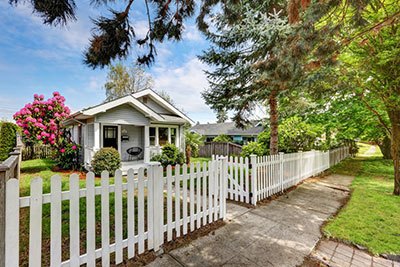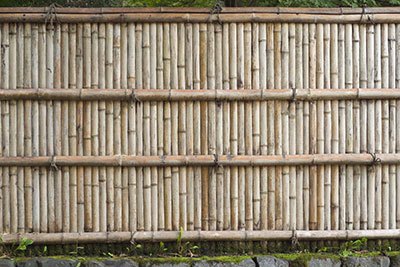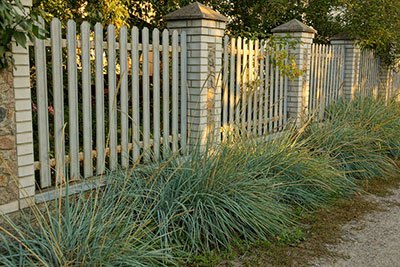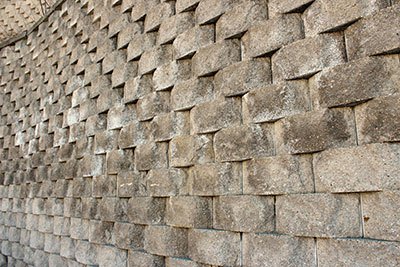Fences serve an important purpose, but they don’t always fit with the look of your landscaping or property. If you’re looking for something to divide space without obscuring sight lines and detracting from a natural aesthetic, what can you choose instead?
In this blog post, we’ll explore some creative alternatives to traditional fencing so that you can create a beautiful outdoor area while still getting all the functional benefits of a fence.
Whether you prioritize style over function or vice versa, there are options available-everything from garden living wall to bollard dividers –– for homeowners seeking ways to divide spaces without actually putting up a fence. Read on for more!
Take away key points:
- Alternative fencing options can add a unique touch to your outdoor space.
- Options for alternative fencing include natural screens, walls, water features, plants, and decorative enclosures.
- When considering alternative fencing, think about factors such as privacy, style, maintenance, and budget.
- Adding flowers and climbing windes are only several of the unique ways to make your fence more attractive.
- Planting trees or shrubs, adding water features, using plants as decorative features, colorful flowers, hanging curtains or screens, hanging baskets, and growing a vegetable garden or flower bed are some alternative fencing options.
Table of Contents
Natural barriers
Fences have become a common way to provide privacy, security, and borders to our properties, but they’re not the only option.
Natural barriers, such as hedges, shrubs, and trees, have been used for centuries to partition land, ward off wildlife, and provide privacy.
1. Landscaping for privacy
If you’re looking for a natural alternative to fencing, consider using plantings strategically to create a private outdoor space. Here are a few landscaping fence ideas:
Choose evergreens

Evergreen deciduous trees and shrubs offer a great choice for year-round coverage and privacy. These trees are the perfect solution for nosy neighbors as they can drown majority of the noise. Consider planting the following plants for a privacy fence:
– Arborvitae
– Yew
– Holly
– Juniper
These choices are hardy and offer great coverage throughout the seasons.
Add tall grasses
Tall grasses offer an attractive and more flexible solution to traditional fencing. Try adding grasses such as:
– Feather reed grass
– Switchgrass
– Big bluestem
These grasses can be scattered throughout your yard or bunched on the edges to add texture and movement. Plus, they can create a privacy fence while still behind one of the best cheap fence ideas.
Incorporate perennials
Perennials can also offer an effective and beautiful solution to privacy fence concerns and is one of the best ways to hide a fence with plants. Select tall, bushy varieties such as:
– Joe Pye weed
– Coneflowers
– Black-eyed Susans
2. Hedgerows and Shrubbery as fencing alternatives
Another natural and beautiful alternative to traditional fencing is using hedgerows and shrubbery to create a boundary around your property. These plantings offer a more structured approach to a natural barrier, and can be a great option for those who want a defined boundary with plenty of natural beauty.

Boxwood
Boxwood is a popular choice for hedgerows, as it can be easily trimmed to form a dense, formal wall. This evergreen shrub can provide good coverage all year and thrives in full to partial sun. Also, it might even require less maintenance than other plant types and other materials.
Privet
Privet is another great choice for a natural hedge fence. It’s relatively fast-growing and can be trimmed into a neat shape easily. One note of caution, though – privet is considered invasive in some areas, so make sure to check with your local nurseries or horticulturalists before adding it to your garden.
Other shrubs
There are a variety of other shrubs that can be used to create a natural barrier around your property while still being one of the best cheap fence ideas. Consider species like:
– Barberry
– Forsythia
– Burning bush
– Brushwood fence posts
All of these shrubs form bushy, dense foliage that can provide good coverage in a relatively short amount of time. Our favorite are the brushwood fences, as they offer the perfect privacy fencing with minimal cost, low maintenance, and long-lasting durability! If done with care, brushwood makes it difficult for the small animals and unwanted visitors to enter your property!
3. Planting trees as privacy screens
Another great alternative to using traditional fencing is planting trees to serve as a natural privacy screen. This option can be especially useful if you’d like to create a border around your property that isn’t as visible from the road as traditional fencing.
Here are a few tips for using trees as a privacy screen:
Select tall, evergreen trees
When choosing trees for a privacy screen, select those that are tall, fast-growing, and evergreen. Some popular choices include:
– Leyland Cypres
– Emerald Green Arborvitae
– Italian Cypress
– Thuja Green Giant
All of these choices can grow to be very tall (up to 30 feet or more), and provide year-round coverage.
Plant trees in rows
To create a natural fence, plant trees in rows that are close together. This can create a dense wall of foliage that will provide plenty of screening and privacy. One note of caution, though – be sure to plant your trees far enough away from buildings and sidewalks so that their root systems won’t cause damage.
Provide adequate water and sunlight
To ensure that your trees grow up healthy and strong, be sure to provide them with plenty of water and adequate sunlight. Also, be aware that some tree species are better suited to certain growing regions than others, so choose varieties that do well in your area.
Decorative enclosures
If you’re looking for a fencing alternative that adds visual interest to your outdoor space, decorative enclosures can be a great option. These structures can be used to create borders and enclosures around your property, while also providing beauty and style while they create privacy.

1. Decorative & corrugated metal panels
One popular choice for decorative enclosures and physical barrier fences is to use corrugated metal panels with decorative designs. These can be made from a variety of metals, including wrought iron, steel, and aluminum, and can feature intricate patterns or simple designs. Corrugated metal panels can be used to create semi-private boundaries that don’t obstruct your view of your surroundings.
If you already have an existing fence, using metal panels is one of the best privacy fence ideas! The fence panels require minimal labor costs and will ensure your privacy in your own secluded oasis!
2. Freestanding retaining walls
Freestanding retaining walls can also serve as excellent fencing alternatives. These walls can be made from a variety of materials such as brick, stone wall, or concrete, and can be customized with decorative elements to match your landscaping or exterior design.
Freestanding walls can also be used to create raised garden beds or outdoor seating areas.
3. Stone and brick pillars
Another great option for decorative enclosures is to use stone wall or brick pillars with decorative elements. These pillars can be used to support a simple gate or arbor, or can be designed to include intricate carvings or personalized plaques.
Stone fence or brick pillars can offer a classic look that’s perfect for traditional homes or gardens.
Decorative enclosures offer a unique and stylish alternative to traditional fencing. Whether you choose corrugated metal panels, retaining walls, or stone pillars for your enclosure, it’s sure to add visual interest and style to your outdoor space.
Outdoor features as boundaries
Outdoor features such as water features, pergolas, and trellises can also be used as boundaries instead of traditional fencing. These features offer unique and creative options for defining your outdoor space while also adding aesthetic appeal.
1. Water features as privacy walls
Water features such as fountains, waterfalls, and ponds can serve as unique and stylish privacy walls. The sound of running water can also provide a soothing ambiance to your outdoor space.
Additionally, water features can be a great way to create a separation between different areas of your yard, such as a patio or seating area.
2. Pergolas and trellises for boundary lines
Pergolas and trellises can also serve as beautiful options for outdoor boundaries. These features can be custom-built to fit your space and come in a variety of materials including wood, vinyl, and metal.
Pergolas can offer partial coverage while still allowing for plenty of light and views, while trellises can be used to support climbing plants (such as roses or ivy) to create a lush and vibrant boundary.
Although it is a costly solution, the natural materials offer complete privacy screening and is one of the best ways to create and outdoor living room.
3. Natural screens like bamboo fence or reed fencing
Lastly, natural screens like dried bamboo or reed fencing can also offer a unique alternative to traditional fencing. These screens come in a variety of heights, textures, and colors and can be used to create a natural and eco-friendly border for your property.
Bamboo grows quickly so you can even buy it in pre-made rools for the living border and give your fence a rustic charm!
Additionally, using natural screens can be a more budget-friendly option than traditional fencing.
Creative fence alternatives
If you’re looking for a unique and creative way to define your outdoor space, there are several fence alternatives to traditional fencing that you can consider. These options can add a touch of whimsy to your garden or provide a functional barrier around your property.
1. Gabion walls
Filling metal cages with rocks produces gabion walls. The cages are typically made of wire mesh, and the rocks can be chosen in a variety of colors and sizes to create a customized look.
Gabion walls can provide a rustic and natural-looking barrier that’s also functional.
2. Living walls and vertical garden
Living walls and vertical garden is a great alternative to traditional fencing if you’re looking for a more eco-friendly option.
Living walls can be created using a variety of materials such as pallet fence, wooden fence frames, or modular systems and can be used to grow an array of plants.
Vertical garden is a similar concept but are often built into freestanding structures. Both living walls and vertical garden can help to improve air quality while also adding visual interest to your outdoor space.
3. DIY alternatives like upcycled pallet walls
If you’re handy with tools, you might consider building a fence using upcycled materials like wood pallets.
Pallet fences can be used to create a variety of structures, such as freestanding walls, trellises, or even a multi-level garden. DIY alternatives offer an opportunity for customization and can often be at a more affordable price than several alternatives that also block neighbor’s view.
Creative fence alternatives to traditional fencing can be a fun and inspiring way to add new fence life to your outdoor space. Gabion walls, flowering plants, brushwood fences, living walls, vertical gardens, and DIY alternatives like upcycled pallet walls are just a few options to consider when looking for a fencing alternative that’s both functional and stylish.
Advantages and disadvantages of fencing alternatives
1. Advantages
– Cost-effective: Fencing alternatives are usually more cost-effective than traditional fences. For example, a hedge or a row of bushes can act as a natural barrier to your property and only requires maintenance every once in a while, saving you money in the long run.
– Aesthetic value: Fencing alternatives often add an aesthetic value to your home that traditional fences cannot always do. A garden wall or a living fence can enhance the beauty of your property and add a touch of elegance.
– Eco-friendly: Fencing alternatives are often eco-friendly or sustainable options. A living fence made from plants can help reduce your carbon footprint and can be a great way to retain natural wildlife habitats.

2. Disadvantages
– Limited security: Fencing alternatives may not provide as much security as traditional fences. A hedge or a garden wall may not be as effective at preventing intruders from entering your property, which can be a significant disadvantage.
– Maintenance: Fencing alternatives, such as living walls or hedges, require maintenance such as pruning or trimming. This can be a time-consuming job, especially if you have a large garden or property.
– It takes time to establish: If you choose a living fence or hedge as an alternative to traditional fencing, it will take time to establish, sometimes up to a few years. This can be a disadvantage if you are looking for a quick solution to protect your property.
FAQs
What can I use other than a fence?
Instead of a traditional fence, you can use hedges or shrubbery, stone or brick walls, wood slats, living walls or vertical gardens, climbing vines, water features, or decorative enclosures.
How can I make my yard private without a fence?
To make your yard private without a fence, you can grow a vegetable garden or flower bed, plant trees or shrubs, corrugated metal fences, a stone wall, hang outdoor curtains or screens, or use plants as decorative features.
What is the easiest DIY fence to install?
The easiest DIY fence to install would be a picket fence, chain-link fence, split rail fence, or bamboo fence.
Is it worth it to DIY fence?
DIY fencing can be cost-effective and customizable, but it can also be labor-intensive and potentially compromise quality if you lack experience. Whether it’s worth, it depends on your budget, skill level, and time constraints.
Final words
Overall, there are many creative and functional alternatives to traditional fencing that can add a unique touch to your outdoor space. Whether you choose to incorporate water features, vertical gardens, or natural screens, the possibilities are endless.
It’s essential to consider your specific needs and preferences when selecting an alternative to fencing.
So, get creative and explore your fence ideas options, and enjoy your beautiful and private outdoor space!
